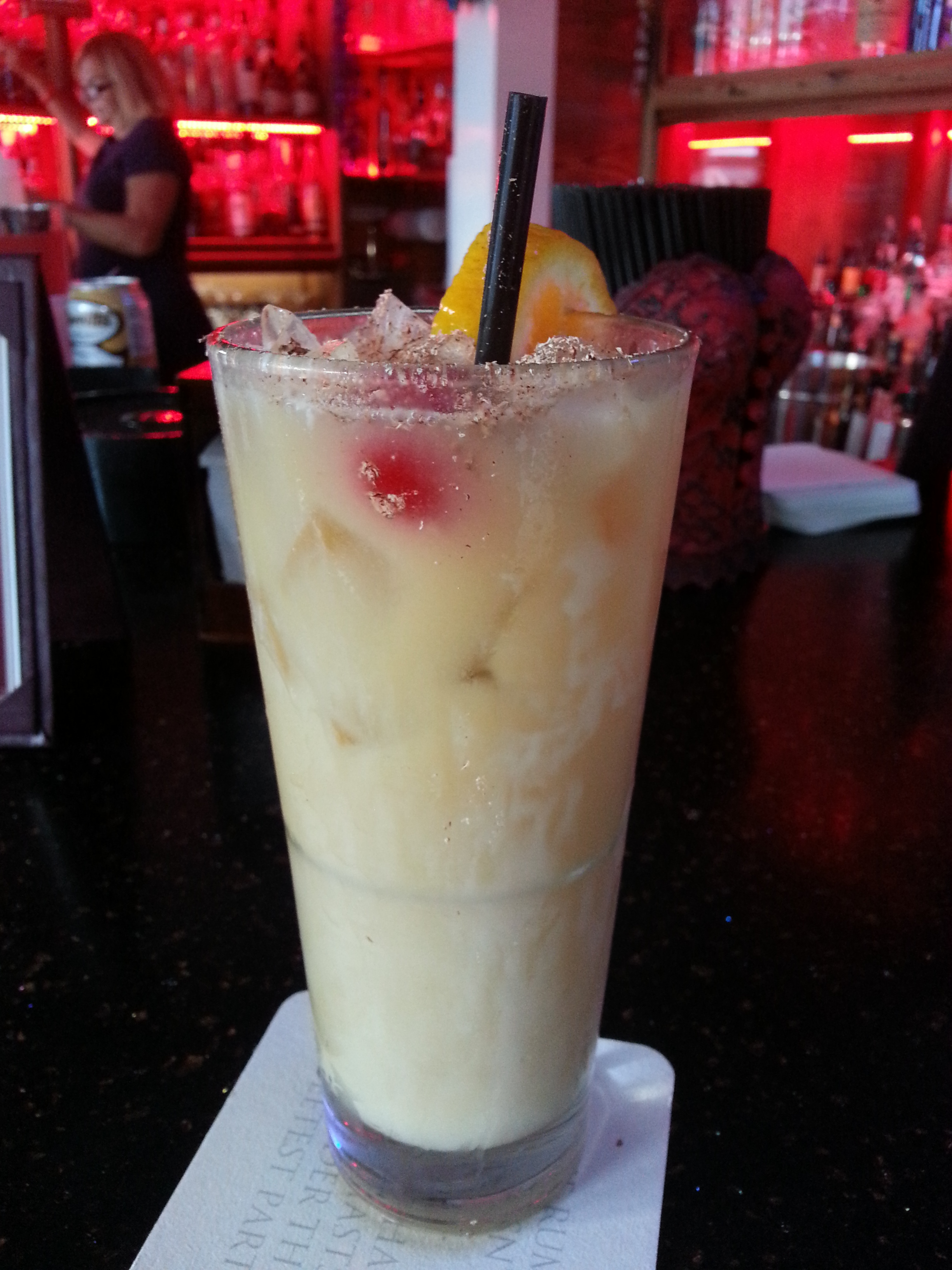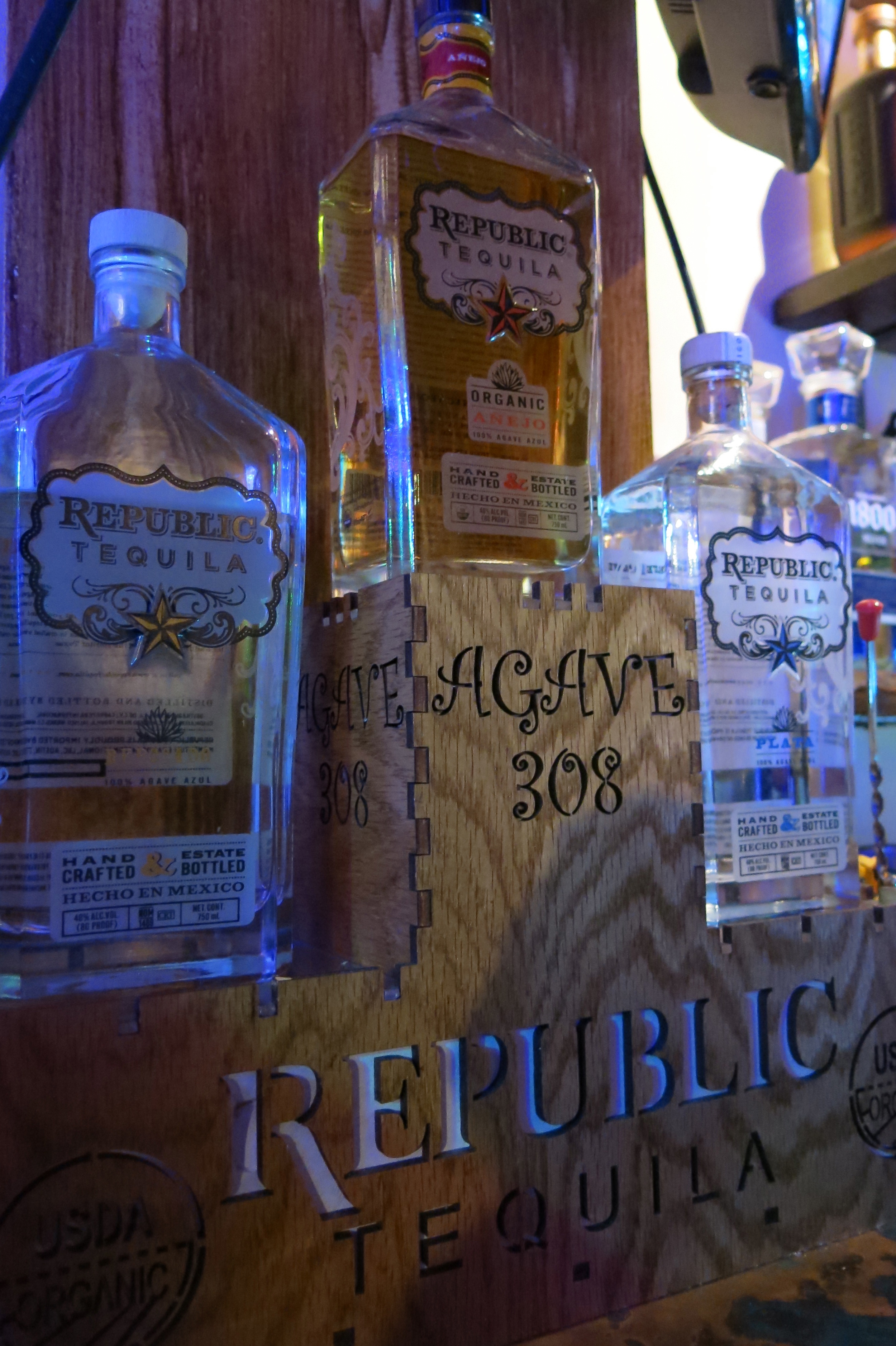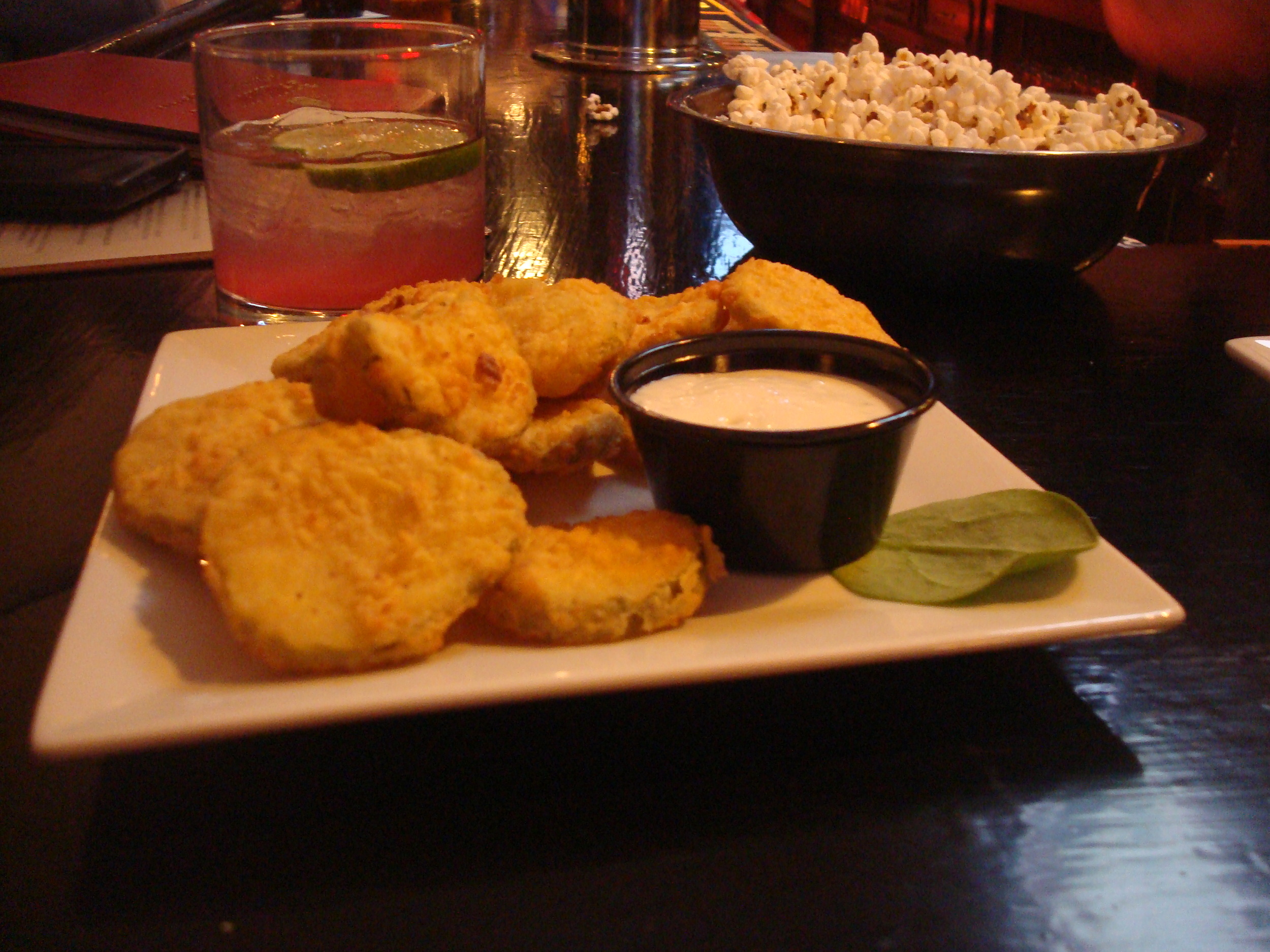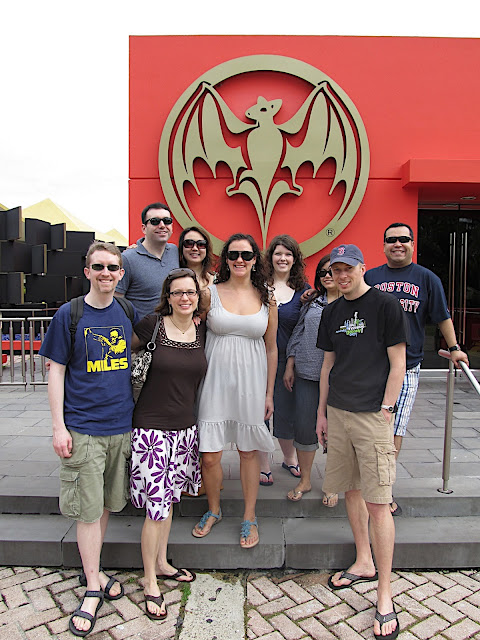Lion's Tail
One for the Road – Key West: The Adventure Continues
About a year ago, my travels took me to one of the most celebrated tourist destinations in the United States – Florida’s Key West. It’s a city rich in culture, legend, and history; but since the occasion of my visit was my brother’s bachelor party, the vast majority of my sightseeing was relegated to the island’s many bars. I can’t say I had any complaints. But Key West is much more than just a cluster of bars. And so I promised myself that if I ever returned, I’d take the time to explore the nation’s southernmost city and get better acquainted with its unique character. This past fall, I did exactly that. With a little more time and a lot less urgency, and accompanied not by 13 other dudes bent on drunken shenanigans but by a small, dedicated team of fellow barhoppers, I was able to immerse myself in all those activities that make Key West famous.
Like getting up close to schools of radiantly colored fish on a snorkeling expedition.
Visiting the onetime home of Ernest Hemingway, a writer whose work earned him a permanent spot in the canon of American literature and whose exploits infuse island lore to this day.
Relaxing with a cigar on a warm, lazy afternoon.
Partaking in a sunset celebration in Mallory Square, with musicians and other street performers putting on a show while the sun gracefully bowed out for the day.
Visiting the concrete buoy marking the nation’s southernmost point and the mile markers designating the start/end point of U.S. Route 1.
Having an obligatory margarita at the original Margaritaville.
You could even say we made a few friends this time around.
Now don’t worry – we still did our share of drinking. We chugged down Pirate’s Punch at Captain Tony’s, walking away a few commemorative cups the richer.
We drank craft rum drinks at the Rum Bar at the Speakeasy Inn, listening to tales spun by bartender Bahama Bob.
And there was plenty of cheap, light-bodied beer to help us keep the good times afloat.
All of that might embody the typical weekend in Key West, but we also managed to find a few bars that stood in sharp contrast to traditional island drinking culture.
The Porch
You don’t see many people walking around Duval Street sipping a Guinness. No offense to the godfather of dark beers, but Key West’s perpetually temperate climate naturally calls for lighter fare – Corona, Land Shark, Bud Light, that sort of thing. Even the choosiest beer snobs tend to adopt a when-in-Rome attitude in the Keys. And that’s what makes a Key West craft beer bar so unusual.
The Porch occupies one half of the Porter Mansion, one of the oldest houses in Key West. Built in 1839, the mansion is named for Dr. Joseph Yates Porter, Florida’s first public health officer, who lived in the house for eight decades. Despite his death in 1927, some say Porter never actually left – the house is reported to be haunted.
But The Porch feels more homey than haunted, with two small, cozy rooms, hardwood floors, and a well-worn, scraped-up bar.
Movie posters and other memorabilia adorn the walls, giving the space the atmosphere of a man-cave. But for all its interior charm, the best place in The Porch to drink is, well, the porch.
This spacious veranda, decked out with tables, chairs, and ceiling fans, overlooks the mansion’s garden, with tall, leafy trees helping to keep the sun at bay.
All you need to complete the picture is a good brew, and The Porch offers 18 rotating beers on draft and another 50 or so in bottles. Everglades Pale Ale is one of a handful of local options. Bold but drinkable, with clear notes of citrus, it’s well suited to sipping on a warm afternoon.
High-quality craft cider has also made its way to the Keys. Rekorderlig Pear Cider is light, crisp, and sweet, with a natural, subtle pear flavor.
If beer and cider aren’t your thing, the B. Nektar Meadjito is an unusual mead that features elements of a mojito. It still has a strong honey profile but the sweetness is tempered by hints of mint and lime.
Address: 429 Caroline Street, Door #2, Key West, Florida
Website:http://www.theporchkw.com/
* * * * * * * * * * * * *
The Other Side
The Porch isn’t the only bar to have set up shop in this allegedly haunted mansion. On the other side of the hall is a bar called, appropriately, The Other Side. And like The Porch, it offers something that’s a bit of a rarity in Key West – classic cocktails.
Just as complex microbrews tend to take a backseat to lighter, simpler beers in Key West, you don’t see Manhattans or Old Fashioneds on many drink menus down here. Tiki drinks and rum drinks are norm, and they come in every flavor and variety – from hand-crafted cocktails made by a skilled mixologist to slushy plastic cups full of cheap booze poured out of a machine.
But The Other Side caters to drinkers with a more refined palate, or at least anyone looking for a change of pace from the sweeter drinks that dominate the island. It also differs notably in terms of décor; a marble bar, cushy bar seats, and a fireplace give The Other Side a sense of sophistication that sets it apart from the many dives that populate nearby Duval Street.
Comfortable leather couches, a coffee table, and bookshelf wallpaper make you feel like you’re enjoying a cocktail in a friend’s living room.
Not that it lacks that vital sense of Key West irreverence.
As with The Porch, I didn’t encounter any ghosts in The Other Side, but I did see plenty of spirits (har har har). The Other Side’s cocktail menu is loaded with classic choices like Manhattans, Blood and Sand, and Negronis, along with some inventive twists like the Raspberry Ramos.
Needless to say, there’s a Hemingway Daiquiri available, made with the excellent Papa’s Pilar blonde rum, grapefruit, lime, sugar, and maraschino liqueur, garnished with a generous wedge of grapefruit. This one was a tad sweeter than other Hemingway Daiquiris I’ve had, but I’m sure “Papa” would still be OK with it.
The French 75 is pleasantly dry and effervescent, combining gin, lemon, sugar, and Prosecco.
The unusually named Polish Apple Juice is a variation of the Dalmatian cocktail. Simple and sweet, made with Bison Grass vodka and a rich apple juice, it was like drinking a glass of apple pie.
And our bartender was happy to whip up something that wasn’t on the menu. The Million Dollar Sunrise is a variation of a Tequila Sunrise.
Address: 429 Caroline Street, Door #1, Key West, Florida
Website:http://theothersidekw.com/
* * * * * * * * * * * * *
Agave 308
Rum is unquestionably the most popular spirit in Key West, but tequila might take home the silver. This is, after all, “Margaritaville.” And who knows how much tequila gets consumed via shot glass in Duval Street bars while cover bands tear through classic rock and 80s tunes.
You can get sugary margaritas and shots of Jose Cuervo anywhere in Key West, but Agave 308 is the island’s only bona fide tequila bar.
Named for its address on Front Street, Agave 308 specializes in tequila-based craft cocktails made with fresh ingredients. There’s more than 50 types of tequila, a small selection of mezcal, and not one bottle of sour mix.
Despite being steps from popular destinations like Mallory Square and a block from Duval Street, Agave 308 has a tucked-away, hidden feel to it. Dimly lit, with candles on tables and funky artwork on the walls, it can serve as a respite from the hustle and bustle of those arduous Key West days.
You can, of course, get a margarita here, which by virtue of its being made with fresh lime juice and high-quality tequila will differentiate it from what you might find elsewhere. But bar manager Jules Mavromatis’s drink list is fun and inventive and bears some exploring.
The Basil Citrus Splash seems to be the most popular offering, and it’s easy to see why. Made with Milagro Reposado tequila, orange, agave, and fresh lime. The distinctive herbal aroma of a basil leaf accompanies every sip.
The Mezcalita swaps tequila for mezcal and adds jalapeno for a smoky, spicy twist on a margarita. It’s garnished with grilled pineapple, and bits of chopped cilantro contribute an aromatic freshness.
There’s also a variety of house-infused tequilas, with flavors like ranging from strawberry to pineapple to jalapeno.
I mean, if you’re going to do a shot of tequila, you might as well make it a good one.
Address: 308 Front Street, Key West, Florida
Website:http://agave308.com/
* * * * * * * * * * * * *
On the final night of my trip, before heading out for the evening, my brother and I were sitting in the hotel bar, quietly sipping drinks and waiting for everyone else to get their shit together. At one point we toasted and made a solemn pledge that we would someday return to this quirky tropical paradise. Key West may seem like party central and all that, but having vacationed there twice now with my brother, it’s become a place where we’ve not only drank and laughed but bonded and made a lot of memories (even if some of them are a little hazy).
And one of the great things about Key West is that when you go back, whether it’s a year later or five years, or ten, so much of it looks exactly the way you remember it. Every day will end with a breathtaking sunset.
Sloppy Joe’s Bar will be in the same place it’s been since 1937. Same with Captain Tony’s Saloon.
There’ll be icy rum drinks everywhere you look and plentiful cheap beer to cool you down on a hot day.
With its deep roots and colorful history, much of Key West feels preserved and unalterable. At the same time, the island isn’t impervious to trends. Microbrews, old-school cocktails, and handcrafted drinks will always be exceptions in a city where people like to keep things simple, but Key West is anything but uniform. And I’d like to think when I go back someday, there’ll still be plenty to discover.
* * * * * * * * * * * * *
Copyright © Boston BarHopper. All Rights Reserved.
The Gaff
One of my most depressing bar experiences occurred a few years ago when I met my friend Brian on Moody Street in Waltham for a few drinks and what we’d hoped would be an engaging game of billiards. A simple plan – and one that would have been more feasible were there a pool hall in the area. Determined to not let such a mere technicality diminish the promise of our evening, Brian and I made our way to Robert’s Pub & Grub, a small dive bar that, despite its ramshackle appearance, was supposedly in possession of a pool table. (I cannot say with confidence that that was its actual name; it was also known as Robert’s Restaurant and Bar, and Robert’s Grub, Pub and Pool. The bar has since passed into shadow, and I cannot confirm its true moniker.) Stepping into Robert’s on that particular Saturday evening was like entering a funeral parlor; a somber organist would not have been out of place. Brian and I were the only two souls in there, aside from the bartender, who looked surprised to see us. In the very strictest sense, Robert’s did have what qualified as a pool table…but it was more like the ghost of a pool table. Its faded green felt had accommodated too many damp beer bottles over the years, had had too many drunken players scrape their pool cues across it. Brian and I stuffed a few quarters into the slot, and out rolled 13 balls (for those of you counting at home, that’s two short of a full set, not including the cue ball).
The drumbeat of indignities continued. The pool cues were so warped, we would have been better served by going outside and looking for a couple of sticks or fallen tree branches and playing with those. And the table was crammed into a space that was only slightly larger than the table itself; the walls were so close that for some shots, you had to hold your cue or tree branch at a 45 degree angle.
As we began a game with hastily modified rules, I went to the bar to see what they had on draft. “We just have bottles,” the bartender said, before I even asked. “Bud Light and Coors Light.”
On the plus side, Robert’s did have a good jukebox, in proper working order. And there was no wait for the pool table.
I don’t bring up the now-defunct Robert’s simply for the purpose of kicking its corpse. Rather, I offer it as an example of the kind of establishment that once characterized Moody Street.
If you’re new to the area, that might come as a surprise to you. But Moody Street, and downtown Waltham in general, has seen its share of highs and lows over the years. Moody Street was a happenin’ place back in the 1940s and 1950s. There were department stores, movie theaters, dance halls, and an overall a lively vibe. That began changing in the 70s when shopping malls started popping up, attracting most of the stand-alone businesses, and leaving Moody Street a ghost town of vacancies and dives like Robert’s. Not exactly a destination.
But the Waltham City Council stepped in and took steps to revitalize the area, and gradually, signs of life began returning to Moody. Lizzy’s started churning out homemade ice cream, Watch City Brewing started churning out original craft beer, and customers started returning. The Embassy Cinema opened, new businesses refurbished old buildings, and Moody Street began evolving into the bustling center of diversion and diversity that it is today.
And no establishment better epitomizes Moody’s transition from its moribund past to its vibrant present than the Gaff.
Handsome, distinguished, but casual, the Gaff is a modern bar with classic charm and a genuine sense of character. Having recently celebrated its third anniversary, the Gaff is still a relative newcomer to Moody Street – yet it feels much older. The crisp black and white color scheme, with beautiful dark wood and a light-colored hardwood floor, look brand new and well cared for, but its personality is more akin to that of its longer-tenured peers. Maybe it’s the classic, throwback cocktails they make so well. Or maybe it’s the laid-back, personable staff who seem kind of like next-door neighbors. It just feels like a new bar with very deep roots.
The Gaff is a cozy little place. There are two comfortable and highly coveted leather couches by a large window that looks out onto Moody Street; a bar with 15 chairs that aren’t as uncomfortable as they look, despite their odd, short seatbacks; and about six small tables. The “Local Art Gallery,” a series of framed black-and-white photos on the wall, contributes to the ambience, and a large chalkboard details the Gaff’s extensive and ever-shifting selection of microbrews.
My most recent visit to the Gaff was with Melissa and Kelly on that traditional must-go-out-for-drinks night, the Wednesday before Thanksgiving. We got there around 6:30 and beat the crowd, snagging three seats at the bar. A bowl of free popcorn appeared, much to Melissa’s delight, and we casually began perusing the drink options.
I’ve always been deeply impressed with the Gaff’s beer list; having Gritty’s Black Fly Stout on draft was what initially lured me in several years ago. But a Boston mixologist whose opinion I hold in high regard urged me to check out their cocktails, and I’m glad I did – their drinks are absolutely a cut above everything else in the vicinity. There are faithful classics, smart updates of traditional cocktails, and more than a few contemporary innovations.
I began my night with a sazerac. Made with Old Overholt rye whiskey, Pernod, simple syrup, and Peychaud’s bitters, the Gaff’s version remains true to the celebrated New Orleans cocktail. I…might have gotten a second one.
Melissa opted for a Wild Night Out – tequila with pomegranate liqueur, freshly squeezed lime, and club soda. Mel said it was pretty good, but didn’t blow her away; or maybe she just wasn’t ready for a wild night out.
Kelly outdid both of us with her Vesper Martini. A cocktail that James Bond would surely approve of, this mix of Hendricks gin, Ketel One vodka, and Lillet Blanc was dry and elegant.
As the Thanksgiving Eve crowd began trickling in, we sipped our drinks and took a look at the food menu. The Gaff offers a broad array of comfort food that goes beyond the basic bar staples like wings and nachos. We started with fried pickles – or, as they’re called on the menu, “frickles.” We placed our order and then proceeded to gleefully repeat “frickles” among ourselves for the next five minutes. (You know you’re saying it in your head right now.) Hand-breaded, deep-fried, and served with ranch for dipping, they made for a light start to our evening.
If the frickles (frickles! frickles!) were amusing, the cherry bombs were intriguing. Melissa wondered aloud what exactly constituted a cherry bomb, and the bartender, who apparently has bat-like hearing, swooped in and said they deep fried cherry peppers with cheese, accompanied by a sweet chili sauce for dipping. He described their heat as being similar to that of jalapeño poppers. I’m not sure what kind of poppers he’s been popping, but these babies were intense. He later confessed to being a lover of really spicy food and preferring his Gaff wings with “atomic” sauce, so his barometer might have been somewhat skewed. They were tasty nonetheless, and quickly resolved any sinus issues we may have been experiencing.
Like the appetizer menu, the dinner options offer time-honored bar basics with some modern twists – like the avocado dog. Only a chef with a solid appreciation of irony would take something as nutritionally maligned as a hot dog and pair it with an avocado. Needless to say, my mind was quickly made up. A quarter-pound hot dog with bacon, caramelized onions, and avocado, served with fries, it was delicious. And healthy! (The avocado makes it healthy; this is known.)
Kelly opted for the Gaff burger, topped with bacon, cheddar, and a fried egg over easy. She’d never had an egg on a burger and was a little unsure about the concept; but the bartender allayed her fears, and I recounted how I’d had something similar at the Intermission Tavern and that she was in for a treat. (I left out the fact that the volume of food would probably render her groggy.)
Our appetites satiated, we turned our attention back to drinks. All tuckered out from her Wild Night Out, Melissa opted for a glass of sangria, which the Gaff spruces up with tequila, St. Germaine, and pineapple juice.
Kelly got a Moscow Mule, which was well made and served in a classy copper cup that reminded me of my experience at Stoddard’s.
If the cocktails, excellent as they are, fly under the radar, it’s because the Gaff’s beer list gets most of the attention. And justifiably so – with about 20 beers on tap and many more in bottles and cans, the Gaff boasts one of the best selections outside of Boston. They offer an extensive and varied selection of microbrews, along with plenty of old favorites.
First up for me was Kentucky Bourbon Ale. I’ve been hooked on this slow-sippin’ beer since I first tried it at the Tip Tap Room, and I was excited that the Gaff had it on tap. I followed that up with the lighter High & Mighty Beer of the Gods.
As if the beer selection wasn’t already stellar, the Gaff also has a cask option. Cask conditioned beers are uncommon enough in Boston, let alone outside the city. The cask beer while we were there was Haverhill Commuter Ale, which Kelly got.
By 9 p.m., Thanksgiving Eve at the Gaff was in full swing. I found myself reflecting on how much I like the place and how happy I am that it’s so been successful. I’m further glad that Moody Street itself has grown into a neighborhood that maintains a sense of character. It could just as easily have become overrun with bland chains like Applebee’s. Instead it’s populated mostly by independently owned businesses, the way it was back in its glory days. The result is an eclectic mix of cocktail bars, Irish pubs, tapas restaurants, ethnic grocery stores, retail shops, sports bars…and yes, a few divey relics of the 70s and 80s. But those humble, townie bars that remain simply represent more choices in an area with tremendous variety. And it’s good to have a few of those places; as I learned when Sadie’s shut its saloon doors, it can be hard to say goodbye to some of them.
Maybe that’s what inspired Kelly and me to close out our night with a couple of classics.
Old beers in a new bar – one that helps chart a new direction for Moody Street while honoring its past.
Last Call
Maybe my perception is influenced by the pictures on the Gaff’s Facebook page of the new owners demoing the previous site and building a new bar, but this place feels like someone’s pride and joy. I get the sense that it’s a product of original ideas and a lot of elbow grease – not some prefabricated bar or restaurant assembled overnight by a soulless corporation. It feels very personal.
Nowhere is that pride of having built a successful bar from ground up more evident than in the enthusiasm of the staff. They get excited about getting a new beer on draft. They get excited about their fun regular events, like nights devoted to 80s music, soul music, and trivia, along with periodic comedy and open mic nights. And I don’t know exactly what constitutes the Gaff’s “midweek drinkers club,” but I feel like I should look into joining.
The prices are a refreshing change from Boston. Our outstanding cocktails ranged from $7 to $9, and the microbrews were around $6 (the Schlitz and the PBR, $3.50). The frickles (!) were $5, the cherry bombs $6. My awesome avocado dog was a mere $7, and Kelly’s burger was $11, which was a good deal considering it encompassed both breakfast and dinner. Both are available more cheaply if you forgo the accoutrements (but why would you?).
I stopped in very briefly on the following Saturday afternoon. As expected, it was pretty quiet, with just a handful of customers; but the atmosphere was still surprisingly upbeat. The bartender regaled me with an amusing tale about his aversion to caffeine, then put on some Motown tunes, which resulted in most of the six patrons singing quietly to themselves (and the bartender singing not so quietly). It again made the Gaff feel very familiar, like drinking in a bar that your friend opened. That seems appropriate – as noted on their website, “gaff” is Irish slang for home, as in “Let’s go back to the gaff for a pint!”
I haven’t been there enough to call it home. But I’ll stop in for a drink and a laugh anytime.
Address: 467 Moody Street, Waltham
Website:http://www.thegaffbar.com/
Stoddard's Fine Food & Ale
Back when Boston BarHopper was in its infancy, and I’d talk with people about cool bars, craft cocktails, and the reasons why I was writing a blog, the establishment that was most consistently recommended to me was Davis Square’s Saloon. And with good reason – devoted to pre-Prohibition-era America, Saloon transports its customers back to the early 20th century with faithfully re-created drinks, food, and décor. I can understand people’s enthusiasm.
What is less clear is why I so rarely hear people raving about Stoddard’s – a Downtown Crossing bar that also pays homage to the American saloon era. And to great effect.
Stoddard’s certainly isn’t obscure – on the few occasions I’ve been there, it’s been at least respectably busy, and sometimes totally packed. And Boston Magazine named Stoddard’s’ Moscow Mule one of Boston’s 30 best cocktails last year, so it’s not like the place has somehow gone unnoticed. I just don’t hear about it that often. And I know I’m not the only one – most people I mention Stoddard’s to either haven’t heard of it or are only vaguely familiar with it.
Maybe it’s the location. Nestled away on a Downtown Crossing side street, it’s not terribly visible. Or maybe it’s the name. “Stoddard’s” sounds kind of…stodgy. Old fashioned.
It’s old fashioned, alright. Similar in some respects to Saloon, Stoddard’s vividly recalls an age gone by. But while Saloon is painstakingly crafted to look like a bar from the turn of the century, Stoddard’s has the street cred to back up its historical milieu.
Stoddard’s is housed in a building that dates back to the late 19th century. It survived the Great Boston Fire of 1872, which wiped out a huge swath of the downtown area, and was the site of various retail shops that sold, among other things, corsets, sewing machines, and cutlery. (In fact, Stoddard’s Cutlery, for which the bar is named, operates to this day in a Boston suburb.)
The people behind Stoddard’s are more than aware of their building’s long, colorful past, and have designed the bar – from the décor to the food to the drinks – with that history in mind. There are vestiges of turn-of-the-century Boston everywhere, along with specific nods to the building’s former tenants – which explains the framed corsets on the wall (originals from the shop that sold them) and the odd sewing machine here and there. Railings from the original Filene’s store in Boston cordon off various areas of the interior, and the foot rail at the bar is supposedly a piece of the original trolley track from Park Street station.
As I would envision any late 19th century bar or restaurant to be, Stoddard’s is very dimly lit. The only natural light comes from a couple of windows near the front door, and the black wooden floor makes for a decidedly nocturnal atmosphere. Most of the lighting inside comes from, of all things, antique lampposts. Squint a little and you might even mistake them for the gaslight street lamps that illuminated Boston evenings in the 1800s.
The lampposts aren’t the only remnants of a bygone era. The bartenders are nattily attired with vests and ties, recalling the more formal dress that was once standard. You might imagine the large wooden barrels on the floor to have once held whiskey or beer. And they double as makeshift tables, something you might have seen a few decades later in a speakeasy. The walls of exposed brick contribute to the classic appearance, and candles on the bar and tables evoke a sense of intimacy.
And then there’s the bar.
My friend John put it best: “The first time I came in here, I just stood there for a few minutes, staring at the bar, like a dork.”
Actually, there’s nothing dorky about it. The bar at Stoddard’s is spectacular. A vision. Imported from England, the bar itself is 30 feet long, with about 15 or 16 seats. Evenly spaced along its dark wooden surface are 20 shiny silver taps that hold Stoddard’s’ excellent selection of mostly microbrews.
Behind it, a 15-foot-high mahogany structure, reaching from the floor to the top of the high tin ceiling, holds a vast array of liquor bottles. It makes for an impressive sight, to say the least. I wasn’t able to get a good picture of it, mainly because Stoddard’s is so dark. Even in good light, though, I doubt I could capture its grandeur; and it’s the sort of thing best experienced in person. In fact, everything about Stoddard’s seems to say “drinking here will be an experience.” And it is.
John was one of the first people to tell me about Stoddard’s. Homebrewer and co-founder of the wildly successful Brew Dudes blog, John’s a beer aficionado who would be naturally drawn to a place like Stoddard’s, given the caliber of its selection and the beautiful presentation. You might remember him from my post on TRADE, where he closed out our fairly elegant dinner with a can of Pork Slap Ale.
John and I stopped in on an early-September day after work. The bar was pretty quiet when we got there around 5 p.m., but there were about 30 people in the bar area within the hour. As is his custom whenever the situation presents itself, John set his sights on the cask offerings. In addition to its 20 microbrews, Stoddard’s has up to five beers on cask at any given time, which is pretty uncommon around here (it’s generally considered a coup when a place has one cask-conditioned beer available). John went with Haverhill Commuter Ale, a light, crisp beer that set a nice tone for the evening.
I had decided on my first drink even before I arrived. As I mentioned earlier, Stoddard’s’ Moscow Mule is lauded as one of the very best in the city. It’s no wonder why. The presentation alone is like a clinic in great cocktail making. The process starts with the bartender chipping away at a house-made ice block – another throwback to the old days. Then comes a classic copper cup, which keeps that hand-crushed ice intact and, of course, your drink nice and cold. Watching the exterior of the metal cup gradually frost over is one of the subtle delights of drinking a good cocktail. And of course, there’s the drink itself. I enjoy Moscow Mules, but I’ve always found that if the mix is even slightly off, the sharpness of the ginger beer can really overpower the flavor. Stoddard’s version was perfectly balanced – Russian Standard vodka, top-quality ginger beer, and just enough lime. Without question, the best I’ve ever had.
One pleasantly strong round in, and it was time to check out the dinner menu. Not surprisingly, the food menu is stocked with traditional American favorites – chicken pot pie, steak, pork loin, and a few seafood offerings. Out of sheer amusement, we considered ordering the “pot of pickles” on the appetizer menu, and we were intrigued by the ballotine of Vermont rabbit – boneless rabbit stuffed with rabbit mousse and wrapped in house bacon. In the end, we played it fairly safe. John ordered chicken, which he said reminded him of the kind his mom used to make. (With a little prodding, I confirmed that this was a compliment.)
I went with the Stoddard’s burger. Made with fresh ground Meyer Ranch beef and topped with aged cheddar cheese, it was an excellent, generously sized burger.
Meanwhile, we kept exploring the extensive cocktail menu. Stoddard’s separates their drinks into three sections – Classics, Contemporaries, and Puritans (nonalcoholic), and each drink has a date to indicate the year or decade in which it was most popular. True to historical form, Stoddard’s draws inspiration for their drinks from the quintessential guide to cocktail making – Jerry Thomas’s “How to Mix Drinks, or The Bon Vivant’s Companion,” first published in 1862. The recipes have been updated a bit, by necessity, but when you look at a cocktail menu and see terms like “slings” and “flips,” it’s clear that someone’s gone to great lengths to ensure that the character and essence of saloon-era mixology is not forgotten.
Good friend of the blog that he is, John went with the most intense drink he could find – the Zombie. It was a potent mix of Appleton rum, Demerera rum, absinthe, 151 proof rum, grapefruit, Falernum, grenadine, “Don’s secret mix,” and Stoddard’s own house-made bitters. Just watching the bartender mix up this concoction was a treat. The result was sweet and strong, with a pleasant spice that we couldn’t quite identify. I’m guessing that had something to do with the aforementioned “secret mix.” We asked our bartender, Dan, if he’d divulge the secret, but he wasn’t having any part of that.
I opted for a Fogcutter – white rum, gin, brandy, lemon, lime, and simple syrup. A drink that combines gin and brandy might sound pretty intense, but the citrus flavors made it seem surprisingly light. Like the Zombie, the Fogcutter is the sort of drink you’d typically see on the menu at a Chinese restaurant. But John appraised Stoddard’s’ version as “much better than that; it doesn’t have the burn of alcohol,” and I got the sense he was speaking from experience. A painful experience.
We closed things out with a couple of beers. John ordered one of my all-time favorites – Gritty’s Black Fly Stout. Any bar that has this on draft is a winner in my book, and Stoddard’s serves it on nitro; as if it could get any better. And since I wanted to try one of the cask-conditioned beers, I opted for Harpoon Summer. It was the first time I’d ever had my favorite summer beer on cask. Well balanced and not overly citrusy, I treated it as an unofficial farewell to summer.
Before we left, Stoddard’s drink coordinator, Jamie, came by to introduce himself. He offered us samples of Founders Breakfast Stout, a keg of which they’d just tapped earlier that day. It’s a rich imperial stout with notes of chocolate and coffee, and Jamie’s exuberance at having it on draft was understandable. He called it “a mouthful of awesomeness”; I might not have phrased it as such, but I wouldn’t disagree.
Needless to say, any bar with a beer and cocktail selection as extensive as Stoddard’s’ requires a couple of return trips. One thing I learned on my subsequent visits is that for a place I tend not to hear a lot about, Stoddard’s attracts quite a crowd. I’ve been lucky to even find a seat on the couple of times I’ve gone back. Fortunately, it’s a cool experience even if you don’t find yourself sitting at that magnificent bar. Standing beneath a lamppost, resting my beer on a wooden barrel, surrounded by exposed brick, I always get the sensation that I’m drinking outside when I’m here. Looking up at the balconies where they store kegs of beer kind of makes the place feel like an alley (a really nice alley, of course).
I’d love to give you a rundown of all different the beers I’ve tried at Stoddard’s, but I rarely get past the Gritty’s Black Fly Stout on nitro. I make no apologies for that. But I have managed to work my way through some of the cocktails.
As a lover of Mai Tais, I was eager to try Stoddard’s take on this Polynesian-style classic. Served in a tiki glass that gave me visions of Greg Brady falling off a surfboard during an incident-plagued trip to Hawaii, and garnished with a lemon peel and a Luxardo cherry, the Mai Tai was delicious. And that hand-chipped ice just seems to make every drink better.
Next up was the more serious Savoy Blackthorne, made with John L. Sullivan whiskey, dry vermouth, bitters, absinthe. I was a little skeptical; I have an uneasy relationship with both dry vermouth and absinthe. But the Savoy was a surprisingly smooth, slow-sipping drink that felt well suited to the atmosphere.
Throwing back weighty cocktails like that calls for a little sustenance. Deviled eggs? Don’t mind if I do! Stoddard’s’ deviled eggs are pretty good and surprisingly numerous; most places just give you three halves, but here you get three full eggs. I held off on the pot of pickles, although I giggle every time I see it on the menu.
And of course, because I can scarcely resist ordering cocktails with interesting names, I closed out my last visit with a drink called Blood of My Enemies. An appropriately red-hued cocktail that combined Rhum Clément, aperol, grenadine, blood orange, bitters, and lemon peel, it was sweet and sharp with a nice bite.
As I sipped it, I pictured a mountain, with me on top, lemon yellow sun, arms raised in a V...
Last Call
Stoddard’s has so many of the qualities I love in bars. It’s dark, a little hidden, and steeped in one of my favorite eras of American history. More importantly, their attention to detail is exceeded by an obvious love for top-notch beer and cocktails. The beer selection, which rotates frequently, is clearly chosen by someone with an understanding and appreciation for high-quality microbrews. And with regard to cocktails, the bartenders really know their stuff and clearly enjoy their craft.
The food prices at Stoddard’s are by no means cheap, but you don’t have to let them break the bank, either. John’s chicken was $19, and most of the other entrees are about $20. My burger was $14; that’s a little high, but I admit it was a pretty big burger and a delicious one. Appetizers are very reasonable, though. I spent $4 for a generous portion of deviled eggs, and there are a couple of other inexpensive bar bites. Most of the other appetizers are $10 or so, and with options as varied as beef tartare and lobster scallion hush puppies, they’re definitely worth a try. If you’re in the mood for something more basic, a dozen wings will run you a very fair $10.
Drink prices are right on the money. Most of the beers are $6, but you can get a PBR for $3 if you’re feeling especially thrifty. Cocktails range from $9 to $12, most averaging about $10.
There’s a lot to discover here. Whether it’s a new craft beer or a very old cocktail, every drink at Stoddard’s is made or poured with tremendous care. And from the opulent bar to the repurposed relics from Boston’s past, a trip to Stoddard’s is almost like a history lesson.
With drinks!
Address: 48 Temple Place, Boston
Website:http://stoddardsfoodandale.com/
Marliave
On the heels of my cocktail adventures at Scholars, I figured my next post should focus on something a little more run-of-the-mill. A simple bar where I could have a few beers, split a couple of appetizers with my wife Melissa, and call it a night. But our first destination was too crowded to allow for good pictures, and let’s just say the service didn’t inspire us to wait until the Friday after-work crowd died down. So we hopped on over to Marliave for what turned out to be a surprisingly fun and interesting evening – resulting in another cocktail-heavy post. My previous two trips to Marliave had been a mixed bag. While I liked the bar and loved their concept – serving Prohibition-era cocktails – my experiences there had been a little inconsistent.
But my third visit was like a cool, smooth chaser, quickly taking the sting out of the prior bitterness and leaving me with a new appreciation for this fairly unique bar.
Similar perhaps to the era it endeavors to recapture, Marliave is tucked away at the end of an alley in Downtown Crossing. It was originally opened in 1885, and while it hasn’t been in continuous operation since then, the modern version stays true to its late 19th century roots. The exterior is elegant but simple: a black and white façade with wrought-iron accents, gold lettering, and a classic hanging sign.
The interior is upscale yet understated – a low-lit black and white décor, nothing to grab your attention except the glorious collection of liquor bottles. The long, marble bar hearkens back to a time when going out for cocktails was the centerpiece of a very special evening.
There’s a surprising amount of space for what feels like an intimate environment. Marliave has two floors, each with its own bar, and a separate dining room upstairs. The upstairs area was full when Mel and I arrived at 7:15, but we managed to find two seats at the downstairs bar.
I’ve never eaten at Marliave, and since I’d filled up on appetizers at the previous establishment, I didn’t sample the culinary offerings on this visit (for what it’s worth, I’ve heard the food is excellent). Not surprisingly, though, the cocktails are the main event. The drinks are inventive but largely built on the traditional liquors you’d expect to find in the 1920s – whiskey and gin.
As I would at any establishment that has a menu devoted to specialty cocktails, I debated my options for a good 10 minutes. I finally settled on the Ulysses S. Grant. It’s Svedka vodka, Plymouth sloe gin, cranberry juice, seltzer, and lemon. It sounded like a solid, classic, old-fashioned drink. Unfortunately, it looked like this:
Yes, I know what you’re thinking…pink lemonade. Frankly, that’s what it tasted like, too. You know who would never drink this? Ulysses S. Grant. Don’t get me wrong – it was delightful, but my enjoyment of it came at the expense of ribbing from Melissa (thankfully, our other friends hadn’t arrived yet).
While I casually sipped my sophisticated cocktail (read: quickly sucked down my girly looking drink to quell the teasing), Mel and I noticed a small cask behind the bar. As we debated whether it was merely decorative or actually contained something, the bartender told us that inside was 6-week oak-barrel-aged Old Overholt Rye for use in their Manhattans – which, once the choir of angels in my head concluded their divine song, I ordered.
Marliave’s version of the Manhattan is called the Jennie Churchill, named after the mother of Winston. (Legend has it that Ms. Churchill created the Manhattan cocktail, but there’s some dispute to that. Regardless, it makes for a good story.) Combined with the oak-aged rye is Vya sweet vermouth, house-made (yeah, you read that right) cinnamon bitters, and cherries imported from Italy.
Please…I need a minute.
The Manhattan is my favorite cocktail, and I think the best ones are the most traditional, with no extra ingredients or variations. Marliave honors that tradition, the only departure being the cinnamon bitters; they weren’t overpowering, but were enough to distinguish the Jennie Churchill from other versions. And the imported cherries? Molto Bene! How I’ll ever go back to just a plain ol’ Maraschino cherry, I don’t know. I am forever spoiled.
Melissa was especially intrigued by the cherries and was clearly angling to have mine once I’d drained my Manhattan. Being the ever gracious husband, I…offered to split it with her. Fortunately, my half-hearted attempt at generosity was not lost on the bartender, who settled the issue by giving us these:
It was at about this point that I realized how astute and talented our bartender, Brian, was. While Melissa was contemplating her next order, Brian suggested the bar’s most popular cocktail: the Tres Curieux, made with Hendrick’s gin, St. Germaine, lime, grapefruit, Prosecco, and a cucumber garnish. Mel was unmoved by its apparent popularity, so Brian made her a sample. You know, it’s not uncommon to see beer samples handed out; but a cocktail sample? I’m not sure I’ve ever seen that. I mean, that requires some work!
The sample, of course, made Mel feel obligated inclined to order the full cocktail…which was exquisite. I’m a recent convert to Hendrick’s gin; it paired perfectly with the fruit and the Prosecco for a strong drink with natural sweetness. The cucumber garnish added a burst of freshness.
With Mel all set for the next half hour or so, it was time for my next choice. I probably could’ve stayed with those Manhattans for the rest of the night, but with so many other intriguing options on the menu, and a bartender who was clearly devoted to the art of the cocktail, I felt there were new frontiers to explore.
Thus, after more careful consideration, I went with the Waterloo – Bombay gin, Champagne, and lemon. The dryness of the gin, the bubbles from the Champagne, a subtle contribution from the twist of lemon peel…pure alcoholic bliss. Of course, I was again derided for having a girly looking drink.
Waterloo3
Maybe it was the cocktails, maybe it was the thinning post-work crowd, but at this point the evening turned decidedly social. All night we’d been sitting next to a guy who appeared to be a regular, given his rapport with Brian. Our neighbor’s name was George, who, as fate would have it, went to Suffolk University and now teaches in its English department. Since I’m also a Suffolk English department alumni, we hit it off pretty quickly.
George is indeed a regular at Marliave, and once he learned about my little project, he was only too happy to expound upon some of the bar’s lesser-known features. For example, at one point he said, “Hey, want to see something cool for your blog?” and asked the bartender for “a Coke with no glass.” My first thought was that Brian and George had worked out a routine whereby Brian would take the hose for the Coke fountain and fire the contents directly into George’s mouth from the other side of the bar. In fact, they were merely demonstrating that Marliave uses old-fashioned Coke bottles in order to stick with their classic theme (this is a pretty neat detail on Marliave’s part, eschewing fountain drinks for glass bottles; but I confess I was slightly disappointed at not seeing the hose trick I’d envisioned).
classiccoke
Catching up on Suffolk times, engaging in enlightened conversation, learning more about Marliave – this was all great, but George’s best contribution to the night was his knowledge of off-the-menu drink specialties. He implored me to ask Brian for a “smash.” This is Marliave’s version of a whiskey smash, with, as I understand it, Brian’s and George’s customizations. It’s made with Blanton’s single-barrel bourbon, lemon juice, water, agave syrup, with muddled mint leaves and another of those delectable cherries.
This baby was a work of art (and very manly looking).
But George wasn’t the only one to impart some knowledge of craft cocktails. Shortly thereafter, I heard the woman next to me ask Brian whether he could make a Moscow Mule. He responded in the affirmative, of course. You don’t exactly need a Ph.D. in mixology to stir up ginger beer, vodka, and a lime. But then she threw him a curveball – “Do you guys serve real Moscow Mules?” I missed the rest of the exchange, but it was clear that Marliave couldn’t satisfy her request.
I was intrigued by what constituted a real Moscow Mule. She told me that in Lebanon, where she’s from, the drink isn’t made with ginger beer – it’s done with muddled ginger, combined with orange juice or soda, a cucumber, and of course, vodka. If I was accustomed to drinking that version, I too would sneer at the more common ginger beer imposter. She mentioned that this version of the cocktail is pretty much impossible to find around here (which is kind of weird; it certainly isn’t hard to get your hands on fresh ginger). To his credit, Brian said that although he was lacking the key ingredient, he’d look into getting it.
Resigned to not having her authentic Moscow Mule, my new friend was stuck on the menu and couldn’t decide what to get. I recommended she start with the Tres Curieux. She was on the fence, but I told her that it was so good, if she got it and wasn’t completely satisfied, she could put it on my tab. She got it and, of course…loved it.
It was around this time that our friends Mario and Scott showed up and joined the festivities (which were pretty festive at that point). It was around 10:15, Motown music was filling the room, and there were only about 10 people at the downstairs bar (upstairs was full, though). Mel, me, and the girl from Lebanon persuaded Mario to get a Tres Curieux, which he did.
Mario has a knack for getting into conversations with most bartenders, so it wasn’t long before he was chatting with the amiable Brian. They talked about Mojitos – specifically, the proper amount of mint to include.
Mario was soon drinking one and declared that it was one of the best in Boston. And dear readers, Mario hails from Puerto Rico – home of the Bacardi distillery, and where they know a thing or two about Mojitos.
The night started winding down around 11, and the bar was pretty quiet at this point. I rounded out my night with a beer. Marliave doesn’t have any beer on draft; however, they have a small but respectable selection of bottled beer. I went with a Konig Pilsner – a light, crisp conclusion to the evening.
Mel closed out her night with a Jennie Churchill, and Brian thoughtfully included two cherries. Does it get any better?
Last Call
Marliave takes its Prohibition-era cocktails seriously. It’s clear that some hard work went into these recipes, even the simplest ones; you can get a great Manhattan anywhere, but try finding a bar that makes its own bitters and imports cherries from Italy. Being served by a bartender who knows his stuff and clearly enjoys the process of mixing an exceptional drink makes a huge difference.
Marliave isn’t the sort of place you’d go for a few beers. Some might consider it more of a “special occasion” bar. And the drinks aren’t cheap, though at $10, they’re about what you’d pay for craft cocktails anywhere in Boston. But with thoughtful drink recipes and bartenders skilled enough to execute them, each Marliave cocktail feels like a special occasion unto itself.
Address: 10 Bosworth Street, Boston
Website:http://www.marliave.com/home/






























































































